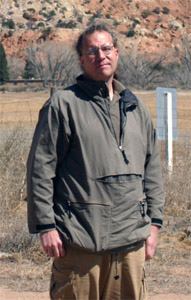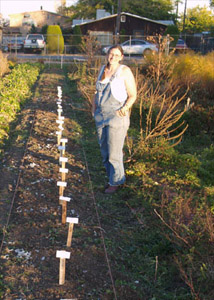
Introduction & ManifestoGiven that there are over 200 million web pages already in existence dealing with kitchen recipes according to the Google search we just did, why in the world is there need for yet more? The answer is found in our background, approach, and goals.
One of the things we want to accomplish with this blog is to introduce you to the diversity of foods and food plants that we humans use. We want you to directly experience the diversity of tastes and smells from across the world’s cuisines. We also want to help you understand the ecological context within which these cuisines evolved. There are often clear ecological reasons why Mexican food is different from Scandinavian or Ethiopian or Japanese, and understanding the ‘whys’ and ‘wherefores’ helps us better connect with our world. But, this is not the only rationale. We are ardent ‘do-it-yourselfers’ that want to keep the food we eat as far away from an industrial chemical lab as possible. Consider transfats, which are a cheap industrial way to turn mass-produced liquid vegetable oils solid. Initially heralded as a health food because it contains little or no cholesterol, we now know they are among the most dangerous things you can ingest. And, don’t even get us started with high fructose corn syrup. Industrial foods are also loaded up with salt and fats (cheap ways to make food taste better), and any number of preservatives to allow them to sit on the grocery shelf for weeks, months, or years. These are not things we want to put in our bodies! For the sake of convenience many people have allowed the industrial-agricultural complex to invade their kitchens and bodies, while at the same time having forgotten the simple pleasures of making their own salad dressing, or mustard, or mayonnaise, to name a few. There is so much that you can easily do in your own kitchen to minimize the corporate takeover of the food we eat, and we want to empower you to do so. Thus, one of the ground-rules for this blog is that we will explore the world of authentic foods using only minimally processed ingredients. For instance, we’ll never call for vegan soy-oil 'butter' or 'mayonnaise' replacements as they have been highly altered through industrial chemical processes. We’ll use only ingredients that we could easily make ourselves if we had the time or resources using traditional kitchen equipment -- like canola, peanut, or olive oil which have been extracted through simple milling. And, there is one last thing we ’d like to accomplish: We want to introduce you to food that is a pleasure to eat. Too often we see people approaching their food as if it were medicine, being willing to put up with anything -- no matter how disgusting -- because it is ‘good for them’. Some of the very worst food we’ve ever been subjected to has been served at harvest parties at a local organic farm and made by people trying earnestly to live in a healthy way. There is no reason for this. Healthy food can and should be every bit as tasty and rich and sensual as any other food. Jeff remembers when he once cooked a vegetarian Middle Eastern meal for his parents, and his father, a died-in-the-wool omnivore who worked his whole life in a meat packing plant and viewed vegetarian food with suspicion if not downright hostility, realized only after the meal was finished that there was no meat anywhere on the table. And, he was amazed, not mad. In order to accomplish this feat we’re not even going to try and pretend to follow all the latest health food crazes. We will use fats. We will use eggs and dairy in our non-vegan dishes. We will use wheat products when they are traditionally called for and our recipes will not try to be gluten free. What we want to do is to bring a bit of real, authentic knock-your-socks off cooking into your kitchen, while at the same time helping you appreciate the Earth’s biological and cultural diversity. And, we want to teach you the simple skills that will allow you to reclaim your kitchen from corporations and industrial chemistry laboratories. Archive |
 First, Jeff has training that is not in the typical fields for food writers: it is not in anthropology or the humanities; the hospitality industry, or the medical sciences. Rather, he comes at food and cooking from the perspective of a PhD-holding ecologist. In his day work he studies biodiversity across biological groups as diverse as land plants, butterflies, and land mollusks (visit his website
First, Jeff has training that is not in the typical fields for food writers: it is not in anthropology or the humanities; the hospitality industry, or the medical sciences. Rather, he comes at food and cooking from the perspective of a PhD-holding ecologist. In his day work he studies biodiversity across biological groups as diverse as land plants, butterflies, and land mollusks (visit his website  Linda learned to love food from the ground up; some of her first and finest childhood memories are of helping her mother and grandmother in the garden and then bringing in freshly picked green beans, peas or beets and feeling pride in helping to provide part of the family dinner. She also learned how to make bread, gather wild foods, and improvise simple but nutritious home-grown meals. As an adult, she brought her skill in producing delicious vegetables to a broader audience as a market gardener for over 20 years. Along with growing vegetables for market, she has been an active outreach educator whose mission is to introduce her customers, students and the general public to the variety of food experiences available through heirloom produce (visit Linda's blog
Linda learned to love food from the ground up; some of her first and finest childhood memories are of helping her mother and grandmother in the garden and then bringing in freshly picked green beans, peas or beets and feeling pride in helping to provide part of the family dinner. She also learned how to make bread, gather wild foods, and improvise simple but nutritious home-grown meals. As an adult, she brought her skill in producing delicious vegetables to a broader audience as a market gardener for over 20 years. Along with growing vegetables for market, she has been an active outreach educator whose mission is to introduce her customers, students and the general public to the variety of food experiences available through heirloom produce (visit Linda's blog